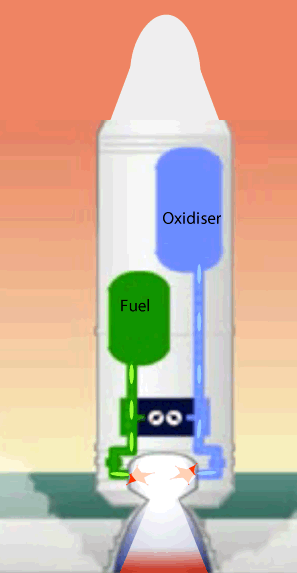Thrust and speed of rockets
Rockets are the most powerful machines humans have ever built. They contain mixtures of extremely hazardous and explosive chemicals which, when ignited, produce powerful forces that drive hundreds of thousands of tons of cargo and fuel into space at speeds approaching 25,000 km/hr.
Two types of rockets exist, liquid fuel and solid fuel. Liquid fuel rockets can be controlled by adjusting the amount of fuel entering the combustion chamber. Powerful pumps and valves help control the flow of fuel and oxidiser flowing into the combustion chamber.
When the fuel and the oxidiser mix they ignite producing gases and a great deal of heat. The hot gases expand quickly and escape through the nozzle at high speed. Escaping gases produce the force of thrust that drives the rocket skyward.
As the gases push down an equal and opposite force (thrust) pushes the rocket upwards.
Because of their incredible speed through the air rockets must have a streamlined shape. A shape that allows them to cut through the air without creating turbulence. The nose cone is especially shaped to reduce turbulence. Turbulence causes the rocket to work harder as it pushes against the air and this burns up more fuel.

Fuels need oxygen to burn. Sometimes gaining oxygen from the atmosphere is not enough for the rapid burning of rocket fuel but it is plenty for the burning of fuel in cars and even jet planes.
We can demonstrate the enormous amount of energy released when we burn sugar. Burning sugar over a hot plate produces a slow reaction that eventually forms carbon. However, if we mix sugar with an oxidant, a chemical that provides oxygen, we can increase the rate of burning with spectacular results.
The video on the right shows sugar mixed with an oxidant, potassium chlorate. Notice the extreme amount of energy released from sugar which can be used to create large forces to lift the rocket off the ground.
What is the force that propels the rocket skyward?
Explain how the force that pushes rockets into the air is generated?
What is the difference between liquid and solid fuel rockets?
What is an oxidiser?
A streamlined rocket reduces